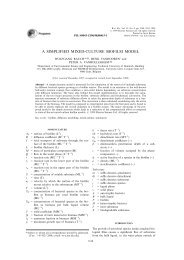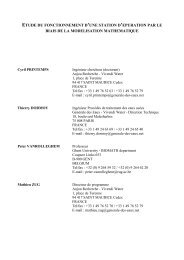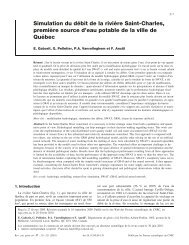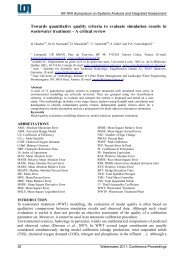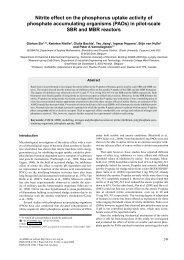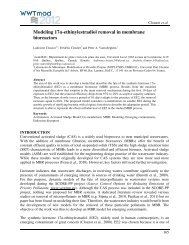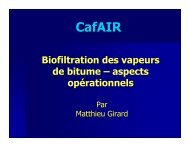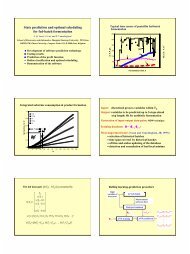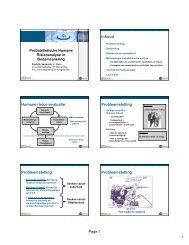Optimal control of the penicillin G fed-batch fermentation: An ...
Optimal control of the penicillin G fed-batch fermentation: An ...
Optimal control of the penicillin G fed-batch fermentation: An ...
Create successful ePaper yourself
Turn your PDF publications into a flip-book with our unique Google optimized e-Paper software.
26 J. F. VAN IMPE ET AL.Table 11. <strong>Optimal</strong> and suboptimal <strong>control</strong> resultsB =<strong>Optimal</strong> <strong>control</strong> <strong>Optimal</strong> 3000 22.321 349-987 350.101 8319.461 1-oooOHeuristic <strong>control</strong> pcrit 3000 22.337 350.037 350.151 8319.239 0.9999B= lo-*<strong>Optimal</strong> <strong>control</strong> <strong>Optimal</strong> 326 0 277.205 277.320 4564.455 1.ooOOHeuristic <strong>control</strong> <strong>Optimal</strong> 1000 12.225 304.665 304.792 4553.437 0 * 9976Heuristic <strong>control</strong> kLcdt 7000 29.573 292-890 292.995 4399.589 0.9639shows <strong>the</strong> corresponding time pr<strong>of</strong>iles. Let us make <strong>the</strong> following remarks.1. From Table11 we note that <strong>the</strong> optimal initial substrate amount SO is ra<strong>the</strong>r low ascompared with <strong>the</strong> total amount available, (Y = 205 500 mol, resulting in a small first<strong>batch</strong> phase [0, t ~] <strong>of</strong> 22-32 h. In fact, <strong>the</strong> singular interval [t2, t3] takes most <strong>of</strong> total<strong>fermentation</strong> time tf. The terminating <strong>batch</strong> phase [t3, t f ] is negligibly small.2. From <strong>the</strong> pr<strong>of</strong>iles for Cx(t) and P(t) (Figure 4) we conclude that although <strong>the</strong> optimal<strong>control</strong> algorithm is based on <strong>the</strong> conjecture <strong>of</strong> a biphasic process, this biphasicbehaviour has disappeared almost completely as compared with e.g. <strong>the</strong> results for <strong>the</strong>constant strategy <strong>of</strong> Figure 2. Principally this is due to <strong>the</strong> structure <strong>of</strong> <strong>the</strong> specificproduction rate 7r in (3), which represents a direct coupling between product syn<strong>the</strong>sis andbiomass growth.3. On <strong>the</strong> singular arc [t2, t3] <strong>the</strong> optimal <strong>control</strong> seems to maintain p at <strong>the</strong> lowest possiblevalue (p = brit) which still guarantees <strong>the</strong> maximum possible value for 7r. We have shownin Reference 4 that during singular <strong>control</strong> C,(t) (and thus p(t) and a(t)) is time-varying,since kh # 0. However, kh is so small that <strong>the</strong> resulting variations in C, (and thus in pand a) are in fact negligible, so that <strong>the</strong>y cannot be detected on this plot.4. It is important to see that <strong>the</strong> optimal <strong>control</strong> keeps ?r on its maximum value for all t < l3.This will be at <strong>the</strong> basis <strong>of</strong> suboptimal pr<strong>of</strong>iles presented in Section 5.5. In order to evaluate <strong>the</strong> performance <strong>of</strong> <strong>the</strong> optimal <strong>control</strong> u*(t), we need somereference. Since we do not penalize <strong>the</strong> total <strong>fermentation</strong> time tf in <strong>the</strong> cost index J[u, xo]in (8), a good choice might be <strong>the</strong> outcome <strong>of</strong> a constant <strong>control</strong> with tf = t; r:denoting<strong>the</strong> optimal <strong>fermentation</strong> time. For convenience we take So,,f = 0 mol. Then we define<strong>the</strong> gain F3 (Yo) asFor B= lo-'' a constant <strong>control</strong> for 350.101 h with SO= 0 produces 1981.283 mol<strong>penicillin</strong>. Thus for <strong>the</strong> optimal <strong>control</strong> u*(t) E u*(B= 0, t) we obtain a gain% = 319-9070. Consider now a constant feed rate strategy. Optimizing <strong>the</strong> initial substrateamount SO and <strong>the</strong> final time tf leads to SO= 90.156 mol, tf= 129.688 h andPf= 3779.012 mol. Observe that this optimal final amount is still far away from <strong>the</strong>optimal <strong>control</strong> result. From this simple parametric optimization we can conclude thatthis model is very sensitive to wards diflerent feeding policies.Observe <strong>the</strong> enormous increase in <strong>the</strong> final product amount P(tf), which may suggest some



